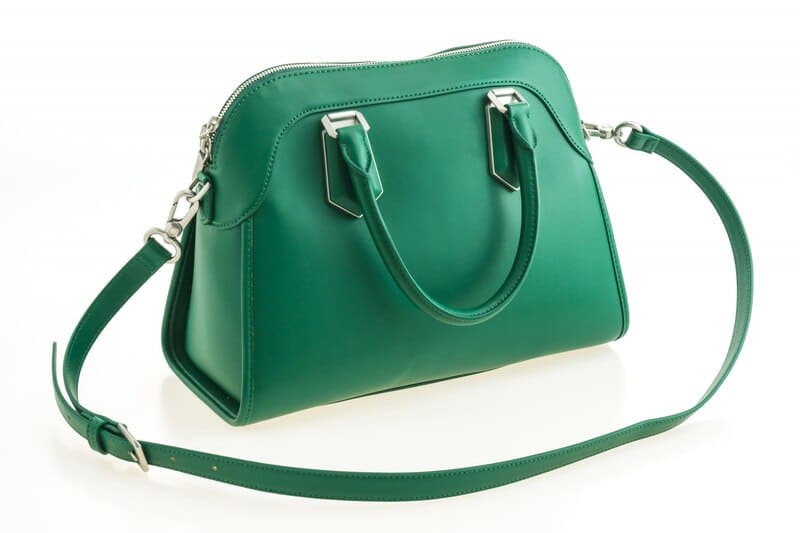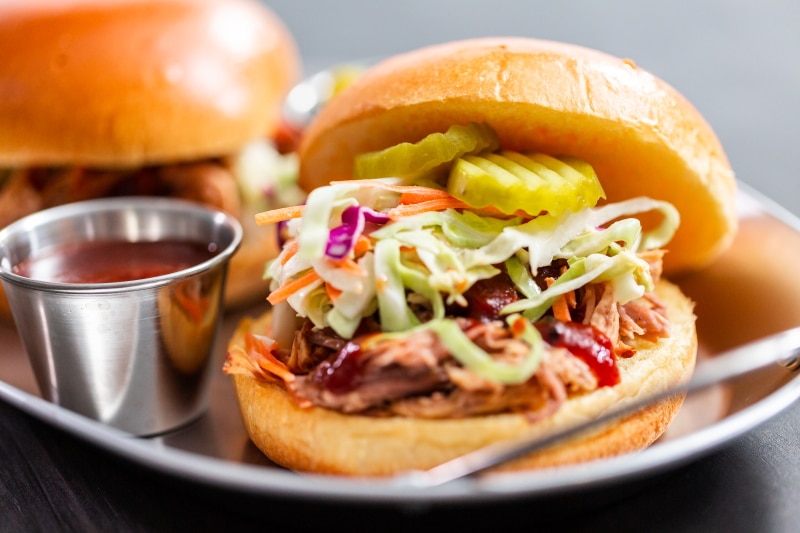There are several alternatives to using animals, such as cactus leaves and mycelium, to create leather. But what, exactly, is vegan leather?
Although it has improved over time, vegan leather hasn’t always had the best reputation. Commonly used interchangeably with the term “quick fashion,” this reputation stems from its tendency to tear, scuff easily, and generally fail to measure up to the quality of the real thing. Vegan leather’s quality has improved greatly in recent years, and designers from Gucci to Ganni now often use it in their collections. Okay, so what exactly is vegan leather?
What is “vegan leather,” anyway?
Vegan leather fabric is a synthetic or plant-based textile that mimics the look and feels of leather without using animal hides.
Polyurethane (PU) and polyvinyl chloride (PVC) are the two synthetic polymers most commonly used in their production, as stated by PETA (PVC). Due to their wrinkled texture, which mimics the look of genuine leather, they are often used.
Concerns regarding the safety and environmental impact of vegan leather have been aroused in particular by these two regularly utilized synthetic materials.
Though more eco-friendly items can be found in the form of cork, kelp, apple peels, and pineapple leaves, very few vegan leathers are really created from these materials.
Does vegan leather hold up?
Vegan leather comes in a variety of grades, and like genuine leather, the greater the grade, the longer it will endure. Faux leather, even when of high quality, is typically less expensive and inferior quality than genuine leather. Contrary to genuine leather, vegan leather quickly wears out. Because of its reduced thickness, it scratches and cracks more easily.
In most cases, leather is created as a by-product of the industrial beef industry. However, it is still a highly sought-after commodity. On the other hand, a by-product is something that is made unintentionally. Depending on the type of vegan leather, the byproducts or co-products used in its creation may be visible.
When compared to traditional leather, is vegan leather more eco-friendly?
The environmental benefits of a plant-based diet have been demonstrated conclusively in several studies, making it the clear choice. But does the same hold true for faux leather?
Vegan leather is less harmful to the environment, according to studies. Luxury goods conglomerate Kering claims in its 2018 sustainability report that its effect might be as little as one-third that of the genuine thing. The effect is proportional to the materials used to create the vegan leather.
Vegan leather has been shown to have a 30% smaller ecological footprint than traditional leather. There are environmental problems, as Sandor himself admits. However, there is data that suggests producing vegan leather has a smaller ecological footprint than producing real leather.
Vegan alternatives may have less of an impact on the environment than the real thing, but they still have glaring drawbacks, especially when manufactured from plastic.
As an item of clothing, plastic poses a risk during its lifetime and afterward if it ends up in water or landfills. Since it takes years for this to decompose and releases harmful chemicals into the environment, it cannot be maintained indefinitely. About 65% of all emissions worldwide may be traced back to the global cattle business, making it one of the most environmentally harmful sectors of the global animal agriculture industry. Brazil’s cattle ranching industry is a major contributor to the destruction of the Amazon rainforest.
UN research shows that the production of meat, dairy, and eggs accounts for 14.5% of all worldwide emissions of greenhouse gases caused by humans.
In addition, chromium, formaldehyde, and arsenic are utilized in the tanning process to create leather. Algae blooms, which kill marine life due to hypoxia (not enough oxygen), are a known side effect of these harmful substances leaking into water streams and disrupting ecosystems.
Workers in the leather tanning industry are also in danger of developing skin diseases and even cancer due to the chemicals used in the tanning process. Collective Fashion Justice, an organization working to create a more ethical fashion sector, sees this effect as a manifestation of environmental racism because the vast majority (95%) of tanneries owned by the United States are located outside of the country.
“What exactly is vegan leather made of?”
If you’re convinced that all of the above is enough to warrant giving vegan leather a try, you’ll be happy to know that it’s advanced significantly from the pleather of yesteryear.

- Synthetic leathers made of PU and PVC
Traditional synthetic leather alternatives like polyurethane (PU) and polyvinyl chloride (PVC) are widely used (PVC). Despite the common misconception that they are the same, the two materials have distinct properties, namely, breathability and durability. While PVC is more sturdy, PU leather is more comfortable to wear.
Both of these leathers are created from plastics that were originally sourced from fossil fuels, so while they are cruelty-free and more resource-efficient than cowhide, they are still not vegan-friendly. Because plastic does not break down, this makes them less sustainable than other vegan leather alternatives. Keep in mind, nonetheless, that even vegan leather has an impact of up to a third smaller than regular leather. Not only that, but it contains no meat or other animal ingredients.
- Mycelium
Mycelium leather, also called “mushroom leather,” is constructed from the fibrous root structures of mushrooms and fungi, which resemble a spider’s web. Mycelium absorbs nutrients and aids in the breakdown of organic materials, making it an essential component of natural forest ecosystems. It’s also useful for creating faux meat and animal-free leather.
It may be used to make things like apparel, purses, shoes, and accessories, and it has a leather-like texture and longevity. It won’t survive forever like synthetic leather does, but it can be integrated into products that also use leather, plastic, or other non-biodegradable components. The French luxury brand Hermès, for instance, created a prototype bag using mycelium leather and animal hide.
Mycelium leather has made its way onto both the runway and the streets. Stella McCartney, Adidas, Ganni, Calvin Klein, and Lululemon are just a few of the brands that have dabbled in mycelium leather. Ecovative, MycoWorks, and Bolt Threads are some of the most prominent companies on the market right now.
- Grapes
This faux leather is produced by an Italian textile firm named Vegea using waste materials from the wine industry. The product can be utilized for a variety of purposes, including but not limited to handbags, shoes, belts, wallets, furniture, and even car interiors.
- Cactus
Adrián López Velarde and Marte Cázarez, two Mexican business people, established Deserto, a manufacturer of cactus leather. The nopal cactus, native to dry climates, provides the leaves for this leather substitute.
Environmental responsibility is a top priority for the firm. After the leaves have been picked, the plant is left unharmed so that the nopal can continue to flourish. Further, it naturally occurs in the environment in which it is cultivated, making it difficult to detect. Aside from that, the nopal cactus can survive on very little water and can take up carbon dioxide.
It has a wide range of applications thanks to its similarity to cowhide leather in being both pliable and airy. H&M, Fossil, Givenchy, Adidas, Karl Lagerfeld, Mercedes-Benz, and BMW are just some of the companies and automakers that have worked with the company.
- Pineapple
Leather from the leaves of the tropical fruit pineapple is crafted from strong cellulose fibers. The London-based firm Ananas Anam produces the only commercially available “pineapple leather,” known as Piatex. Because its foundation is PLA, a thermoplastic, it is not fully biodegradable, yet it is more environmentally friendly than traditional leather. As a by-product of the production of pineapples, Piatex is created through a cooperative effort with the world’s largest pineapple grower, Dole.
Piatex can be used for several purposes due to its adaptability, breathability, and durability. In June of 2021, Nike released a series of summer-themed Air Force Ones with pineapple leather accents. Hugo Boss, H&M, and No Saint have also employed it.
- Corn
There are also alternatives to leather that don’t involve killing animals, such as corn leather. Although it’s not totally biodegradable, this alternative to cowhide is made from corn and polyurethane and is far friendlier to the environment. The likes of Louis Vuitton and smaller vegan labels like Luxtra—which has collaborated with the following item on the list—have taken notice of its longevity and great quality.
- Apple
Apple leather, often called AppleSkin, is a popular material for handbags, shoes, and other accessories since it is made from waste products from the juice industry. This faux leather is not biodegradable because it contains 50% apple scraps and 50% polyurethane.
- Yeast
Yeast, like mycelium, can be found in just about anything these days. Biotech firm Modern Meadow in New Jersey uses collagen fermented from yeast rather than animal sources to create its leather. There are currently no partnerships in this field, although yeast is showing promise as a sustainable alternative to a wide range of animal products.
- Cultivated
While not technically vegan, this leather is produced without the use of any animals in the manufacturing process. Tanned leather starts out as actual bovine cells cultivated in a bioreactor. By feeding these cells, they can be coaxed into taking on the same structure as cowhide leather. Leonardo DiCaprio, a lifelong advocate for environmental protection, made an investment in VitroLabs, a biotech business working on cultivated leather, in May 2022. Celium, a Mexican biotech business, plans to utilize both food waste and cellular agriculture.
The aforementioned synthetic leather alternatives are simply a few instances of cutting-edge textile technology. Leather can also be crafted from used materials such as coffee grounds, plastic, wood, agricultural waste, cork, grains, leaves, and other byproducts of other industries. Just as there are numerous options in the plant-based meat market, leather may be produced in several different ways that do not include the use of animals.








